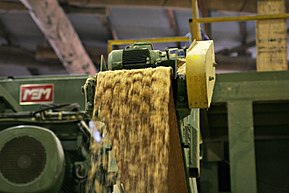Wood flour
Wood flour falls predominantly as grinding dust during sanding of wood on. It can also be obtained by grinding or shredding wood or by-products of wood processing . Depending on the fineness of the saw blade , both sawdust and sawdust are produced when sawing wood . The fine wood flour can be separated by sieving. Milling mainly produces chips.
The fine wood particles that wood-dwelling organisms remove from the wood when drilling holes are also referred to as wood flour.
quality
High-quality wood flour is usually made from hardwood, lower grades from softwood such as pine or fir wood . The smaller the grain sizes , the less the influence of the type of wood. The water and ash content as well as the proportion of resins , fats and waxes are important for further processing .
composition
The composition of wood flours largely corresponds to that of wood and contains alpha cellulose (up to 55%), hemicellulose (up to 25%), lignin (up to 30%), water (up to 6%) and minerals as well as waxes and fats.
use
Wood flour is increasingly being used for the production of fibreboard and wood pellets for heating purposes.
Wood flour has been an important raw material for linoleum production since the beginning of the 20th century and served as a filler in the production of Bakelite and coarser composite materials such as wood concrete and wood screed .
Since then, the use of wood flour as a raw material for building products has stagnated until more recently new wood-plastic composite materials (WPC) have been developed. The wood flour content can be up to 80%; polypropylene is often used as a binding agent . The mixture can usually be processed using molding processes used in plastics technology ( extrusion , in some cases also injection molding ) and still retain a wood-like appearance.
Wood flour is traditionally used as an additive in the manufacture of explosives . In foundry technology, wood flour is mixed into molding sand .
Beechwood flour, which must be free from wood preservatives or pesticides , is preferred for smoking sausage products, ham, fish and cheese .
Because of its absorbency, wood flour is used as bedding in animal husbandry. Some animals are able to digest wood cellulose. It must be guaranteed that wood that is free of harmful substances and non-toxic is used. Yew wood, for example, can cause poisoning.
Bois Durci ([bwa dyʀsiː], French for “hardened wood”) was a natural plastic made from wood flour and ox blood, which was used for decorative objects until the 1920s.
Mixed with quartz sand , pigments and bound with magnesia cement ( Sorel cement ), wood flour is used as a seamless "hard stone flooring". In the 20th century, such wooden stone floors were also known as "stone wood " or "xylolite" as an inexpensive, hygienic and easy-care alternative to wooden parquet in schools, homes and hospitals. Floors in Bauhaus Dessau were also made from the then modern “stone wood”.
Flammability
Wood flour the size of a particle of dust can, when dispersed in air, produce a mixture that burns off as a dust explosion when ignited . Due to the large surface of the fine-grained wood dust, the combustion reaction is accelerated to an explosive course.
Web links
- Material recycling options for residual and waste wood, in particular sawdust and sawdust at Holzfragen.de
- Information from the Baden-Württemberg Ministry of Economics on linoleum
- Wood dust diseases
Individual evidence
- ↑ Duden online: wood flour and sawdust
- ^ Polyvinyl chloride , by Hans K Felger, Hermann Amrehn, Alexander von Bassewitz, Gerhard W Becker (as Google Book)
- ^ Message from the Lower Saxony State Office for Consumer Protection and Food Safety
- ↑ Feeding Our Pets
- ↑ Hard stone floor coverings ( Memento of the original from June 7, 2014 in the Internet Archive ) Info: The archive link was inserted automatically and has not yet been checked. Please check the original and archive link according to the instructions and then remove this notice.
- ↑ GESTIS-STAUB-EX: Database combustion and explosion parameters of dusts ( Memento of the original from June 29, 2015 in the Internet Archive ) Info: The archive link was automatically inserted and not yet checked. Please check the original and archive link according to the instructions and then remove this notice. Institute for Occupational Safety and Health of the German Social Accident Insurance (IFA), as of March 2015.
